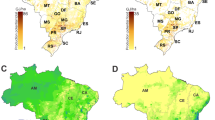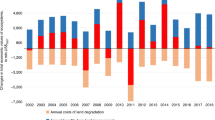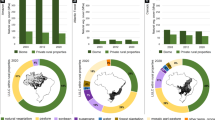Abstract
Competition for land resources is intense, with growing demand for food and resources to support humanity. Despite this, global agricultural area has significantly declined over the past two decades due to socio–political trends, market changes and environmental degradation. Although expensive, restoring degraded lands that are no longer contested for agricultural use due to low productivity may present a major conservation opportunity with minimal social or political opposition. Here we present a new perspective for conservation that highlights the potential conservation value of uncontested lands. We highlight key factors that make lands uncontested, define an approach for evaluating costs and benefits on uncontested land parcels and propose methods for identifying these lands.
This is a preview of subscription content, access via your institution
Access options
Access Nature and 54 other Nature Portfolio journals
Get Nature+, our best-value online-access subscription
$29.99 / 30 days
cancel any time
Subscribe to this journal
Receive 12 digital issues and online access to articles
$119.00 per year
only $9.92 per issue
Buy this article
- Purchase on Springer Link
- Instant access to full article PDF
Prices may be subject to local taxes which are calculated during checkout




Similar content being viewed by others
References
Global Assessment Report on Land Degradation and Restoration (Intergovernmental Science-Policy Platform on Biodiversity and Ecosystem Services, 2018).
Cramer, V. A. & Hobbs, R. J. Old Fields: Dynamics and Restoration of Abandoned Farmland (Island, 2007).
Hardy, M. J., Fitzsimons, J. A., Bekessy, S. A. & Gordon, A. Purchase, protect, resell, repeat: an effective process for conserving biodiversity on private land? Front. Ecol. Environ. 16, 336–344 (2018).
Adams, V. M., Pressey, R. L. & Naidoo, R. Opportunity costs: who really pays for conservation? Biol. Conserv. 143, 439–448 (2010).
Carwardine, J. et al. Conservation planning when costs are uncertain. Conserv. Biol. 24, 1529–1537 (2010).
McCarthy, D. P. et al. Financial costs of meeting global biodiversity conservation targets: current spending and unmet needs. Science 338, 946–949 (2012).
Naidoo, R. et al. Integrating economic costs into conservation planning. Trends Ecol. Evol. 21, 681–687 (2006).
McCann, L., Colby, B., Easter, K. W., Kasterine, A. & Kuperan, K. V. Transaction cost measurement for evaluating environmental policies. Ecol. Econ. 52, 527–542 (2005).
Adhikari, B. & Lovett, J. C. Transaction costs and community-based natural resource management in Nepal. J. Environ. Manag. 78, 5–15 (2006).
Meshack, C. K., Ahdikari, B., Doggart, N. & Lovett, J. C. Transaction costs of community‐based forest management: empirical evidence from Tanzania. Afr. J. Ecol. 44, 468–477 (2006).
Lindenmayer, D., Thorn, S. & Noss, R. Countering resistance to protected‐area extension. Conserv. Biol. 32, 315–321 (2018).
Pannell, D. J., Roberts, A. M., Park, G. & Alexander, J. Improving environmental decisions: a transaction-costs story. Ecol. Econ. 88, 244–252 (2013).
FAOSTAT (Food and Agriculture Organization of the United Nations, 2019); http://faostat3.fao.org/
Poore, J. A. C. Call for conservation: abandoned pasture. Science 351, 132 (2016).
Hanak, E. et al. Water Stress and a Changing San Joaquin Valley (Public Policy Institute of California, 2017).
Benayas, J. R., Martins, A., Nicolau, J. M. & Schulz, J. J. Abandonment of agricultural land: an overview of drivers and consequences. CAB Rev. 2, 1–14 (2007).
Terres, J.-M. et al. Farmland abandonment in Europe: identification of drivers and indicators, and development of a composite indicator of risk. Land Use Policy 49, 20–34 (2015).
Estel, S. et al. Mapping farmland abandonment and recultivation across Europe using MODIS NDVI time series. Remote Sens. Environ. 163, 312–325 (2015).
Renwick, A. et al. Policy reform and agricultural land abandonment in the EU. Land Use policy 30, 446–457 (2013).
Arnaez, J., Lasanta, T., Errea, M. & Ortigosa, L. Land abandonment, landscape evolution, and soil erosion in a Spanish Mediterranean mountain region: the case of Camero Viejo. Land Degrad. Dev. 22, 537–550 (2011).
Lambin, E. F. & Meyfroidt, P. Global land use change, economic globalization, and the looming land scarcity. Proc. Natl Acad. Sci. USA 108, 3465–3472 (2011).
Chen, R., Ye, C., Cai, Y., Xing, X. & Chen, Q. The impact of rural out-migration on land use transition in China: past, present and trend. Land Use Policy 40, 101–110 (2014).
Plieninger, T., Hui, C., Gaertner, M. & Huntsinger, L. The impact of land abandonment on species richness and abundance in the Mediterranean Basin: a meta-analysis. PloS ONE 9, e98355 (2014).
Haddaway, N. R., Styles, D. & Pullin, A. S. Environmental impacts of farm land abandonment in high altitude/mountain regions: a systematic map of the evidence. Environ. Evid. 2, 18 (2013).
Cramer, V. A., Hobbs, R. J. & Standish, R. J. What’s new about old fields? Land abandonment and ecosystem assembly. Trends Ecol. Evol. 23, 104–112 (2008).
Hilker, T., Natsagdorj, E., Waring, R. H., Lyapustin, A. & Wang, Y. Satellite observed widespread decline in Mongolian grasslands largely due to overgrazing. Glob. Change Biol. 20, 418–428 (2014).
Bardsley, P. The collapse of the Australian wool reserve price scheme. Econ. J. 104, 1087–1105 (1994).
Dyer, J. H. & Chu, W. The role of trustworthiness in reducing transaction costs and improving performance: empirical evidence from the United States, Japan, and Korea. Organ. Sci. 14, 57–68 (2003).
North, D. C. Institutions. J. Econ. Perspect. 5, 97–112 (1991).
Hobbs, R. J. Degraded or just different? Perceptions and value judgements in restoration decisions. Restor. Ecol. 24, 153–158 (2016).
King, E. G. & Hobbs, R. J. Identifying linkages among conceptual models of ecosystem degradation and restoration: towards an integrative framework. Restor. Ecol. 14, 369–378 (2006).
Hobbs, R. J. & Harris, J. A. Restoration ecology: repairing the Earth’s ecosystems in the new millennium. Restor. Ecol. 9, 239–246 (2001).
Perring, M. P. et al. Advances in restoration ecology: rising to the challenges of the coming decades. Ecosphere 6, 1–25 (2015).
Suding, K. N. Toward an era of restoration in ecology: successes, failures, and opportunities ahead. Annu. Rev. Ecol. Evol. Syst. 42, 465–487 (2011).
Hobbs, R. Where to from here? Challenges for restoration and revegetation in a fast-changing world. Rangel. J. 39, 563–566 (2018).
McDonald, T., Gann, G., Jonson, J. & Dixon, K. International Standards for the Practice of Ecological Restoration–Including Principles and Key Concepts (Society for Ecological Restoration, 2016).
Mansourian, S. In the eye of the beholder: reconciling interpretations of forest landscape restoration. Land Degrad. Dev. 29, 2888–2898 (2018).
Possingham, H. P., Bode, M. & Klein, C. J. Optimal conservation outcomes require both restoration and protection. PLoS Biol. 13, e1002052 (2015).
Qadir, M. & Oster, J. D. Crop and irrigation management strategies for saline-sodic soils and waters aimed at environmentally sustainable agriculture. Sci. Total Environ. 323, 1–19 (2004).
Kennedy, R. E. et al. Bringing an ecological view of change to Landsat‐based remote sensing. Front. Ecol. Environ. 12, 339–346 (2014).
Bai, Z. G., Dent, D. L., Olsson, L. & Schaepman, M. E. Proxy global assessment of land degradation. Soil Use Manag. 24, 223–234 (2008).
Wessels, K. J., Prince, S. D., Carroll, M. & Malherbe, J. Relevance of rangeland degradation in semiarid northeastern South Africa to the nonequilibrium theory. Ecol. Appl. 17, 815–827 (2007).
Wessels, K. J., Van Den Bergh, F. & Scholes, R. Limits to detectability of land degradation by trend analysis of vegetation index data. Remote Sens. Environ. 125, 10–22 (2012).
Mariano, D. A. et al. Use of remote sensing indicators to assess effects of drought and human-induced land degradation on ecosystem health in Northeastern Brazil. Remote Sens. Environ. 213, 129–143 (2018).
Eckert, S., Hüsler, F., Liniger, H. & Hodel, E. Trend analysis of MODIS NDVI time series for detecting land degradation and regeneration in Mongolia. J. Arid Environ. 113, 16–28 (2015).
Gorelick, N. et al. Google Earth Engine: Planetary-scale geospatial analysis for everyone. Remote Sens. Environ. 202, 18–27 (2017).
Battude, M. et al. Estimating maize biomass and yield over large areas using high spatial and temporal resolution Sentinel-2 like remote sensing data. Remote Sens. Environ. 184, 668–681 (2016).
Johnson, M. D., Hsieh, W. W., Cannon, A. J., Davidson, A. & Bédard, F. Crop yield forecasting on the Canadian Prairies by remotely sensed vegetation indices and machine learning methods. Agric. Meteorol. 218, 74–84 (2016).
Brockington, D., Duffy, R. & Igoe, J. Nature Unbound: Conservation, Capitalism and the Future of Protected Areas (Routledge, 2012).
Fairhead, J., Leach, M. & Scoones, I. Green grabbing: a new appropriation of nature? J. Peasant Stud. 39, 237–261 (2012).
Stevens, S. Conservation through Cultural Survival: Indigenous Peoples and Protected Areas (Island, 1997).
Raymond, C. M. et al. Ecosystem services and beyond: using multiple metaphors to understand human–environment relationships. BioScience 63, 536–546 (2013).
Legge, S., Murphy, S., Kingswood, R., Maher, B. & Swan, D. EcoFire: restoring the biodiversity values of the Kimberley region by managing fire. Ecol. Manag. Restor. 12, 84–92 (2011).
Premauer, J. M. & Berkes, F. A pluralistic approach to protected area governance: indigenous peoples and Makuira National Park, Colombia. Ethnobiol. Conserv. 4, 1–16 (2015).
Stronghill, J., Rutherford, M. B. & Haider, W. Conservancies in Coastal British Columbia: a new approach to protected areas in the traditional territories of first Nations. Conserv. Soc. 13, 39–50 (2015).
Phalan, B., Onial, M., Balmford, A. & Green, R. E. Reconciling food production and biodiversity conservation: land sharing and land sparing compared. Science 333, 1289–1291 (2011).
Balmford, B., Green, R. E., Onial, M., Phalan, B. & Balmford, A. How imperfect can land sparing be before land sharing is more favourable for wild species? J. Appl. Ecol. 56, 73–84 (2019).
United Nations Department of Economic and Social Affairs The Sustainable Development Goals Report 2018 (United Nations, 2018).
Acknowledgements
This work was funded by the Australian Research Council—Discovery Project ‘Global extent of degraded farm lands and their conservation potential’ (ARC-DP170101480). E.M.M. was supported by an ARC Future Fellowship and Z.X. was supported by ARC-DP and the Natural Science Foundation of China (project no. 41801262). We thank S. Brisbane for providing final checks and edits on this manuscript.
Author information
Authors and Affiliations
Contributions
E.M.M. and E.T.G. conceived the initial idea, and all authors developed the concepts and structure of the Perspective. All authors contributed equally to further content development, writing and revisions of the manuscript on their specific expertise.
Corresponding author
Ethics declarations
Competing interests
The authors declare no competing interests.
Additional information
Publisher’s note Springer Nature remains neutral with regard to jurisdictional claims in published maps and institutional affiliations.
Rights and permissions
About this article
Cite this article
Xie, Z., Game, E.T., Hobbs, R.J. et al. Conservation opportunities on uncontested lands. Nat Sustain 3, 9–15 (2020). https://doi.org/10.1038/s41893-019-0433-9
Received:
Accepted:
Published:
Issue Date:
DOI: https://doi.org/10.1038/s41893-019-0433-9
This article is cited by
-
Quantifying the recarbonization of post-agricultural landscapes
Nature Communications (2023)
-
Navigating sustainability trade-offs in global beef production
Nature Sustainability (2023)
-
Regional conditions shape the food–energy–land nexus of low-carbon indoor farming
Nature Food (2022)
-
Climate Change and the Cost-Effective Governance Mode for Biodiversity Conservation
Environmental and Resource Economics (2022)
-
Metal contamination and bioremediation of agricultural soils for food safety and sustainability
Nature Reviews Earth & Environment (2020)



